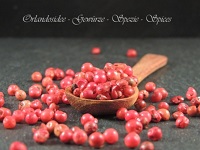
Pink Pepper (Schinus spp.)
Pink pepper are the dried rosy-red berries of Schinus (often S. terebinthifolia or S. molle), an evergreen tree native to South America that now grows in suitable warm climates worldwide. Unlike true pepper (Piper nigrum), pink pepper is delicately sweet, perfumed and only gently warm.
- Botany: Schinus spp. • Family: Anacardiaceae
- Form: fragile whole berries; use crushed or lightly cracked
- Profile: sweet-fruity, floral, lightly peppery with resinous/pine hints
- Best for: seafood, creamy sauces, vinaigrettes, soft cheeses, desserts, pepper blends
Aroma & Taste
Bright, berry-like sweetness and gentle warmth with subtle pine and citrus. The thin husk bursts with aroma; the tiny seed inside is more bitter—crushing releases both, so use sparingly.
Culinary Uses
- Seafood: crack over salmon, scallops or white fish; finish ceviche and fish soups.
- Sauces & dressings: whisk into beurre blanc, cream sauces or vinaigrettes.
- Cheese & charcuterie: sprinkle on goat cheese, burrata or pâtés.
- Sweets & drinks: pair with strawberries, citrus desserts, white chocolate or gin & tonic.
- Blends: combine with white/green peppercorns for a fragrant mixed pepper.
How to Use
- Crack, don’t pulverize: use a mortar & pestle or gentle mill setting; avoid dusting to keep flavors bright.
- Add late: finish hot dishes or fold into sauces off-heat to preserve aroma and color.
- Infuse: steep lightly crushed berries in warm cream, syrup or spirits; strain for silky results.
Dosage & Kitchen Ratios
- Finishing: a pinch (8–12 berries), lightly cracked, per portion.
- Sauces/dressings: 1/4–1/2 tsp cracked per 250 ml (1 cup) base.
- Desserts/infusions: 1/2 tsp cracked per 500 ml (2 cups) dairy or syrup; steep 10–15 min.
Pairings
Dill, chive, tarragon, lemon/orange zest, vanilla, white chocolate, soft cheeses, salmon, shellfish, strawberries and pears.
Ingredients & Allergens
Ingredients: Pink pepper berries (Schinus spp.).
Allergens: none mandatory in EN labeling for this single ingredient.
Storage & Shelf Life
Keep airtight, cool, dry and away from light. The delicate husks fade with light and air—best within 6–12 months. Crack only what you need.
Substitutes & Notes
No true 1:1 substitute. For color and light perfume use crushed pink pepper with a touch of citrus zest; for more heat, blend with white pepper. Do not confuse with ripe red peppercorns of Piper nigrum (different flavor).
FAQ
Is pink pepper the same as black pepper?
No—pink pepper is from Schinus (Anacardiaceae), not Piper nigrum. It’s sweeter and more floral with only gentle warmth.
Can I grind it in a regular mill?
Use a gentle/coarse setting or a mortar; the fragile husks can clog fine mills.
When should I add it?
Near the end of cooking or at the table to protect its color and aroma.
Merchant contact: Orlandosidee — Spice Shop (see site imprint for full company details). Email: info(at)orlandosidee.de



